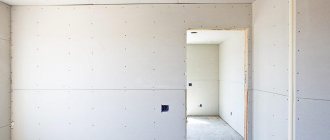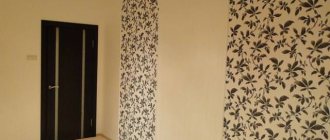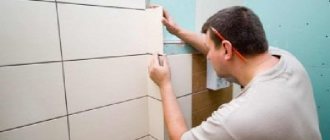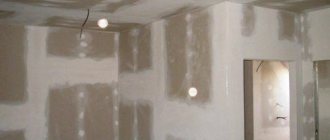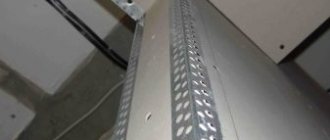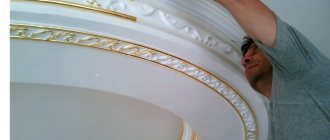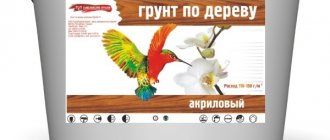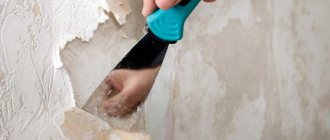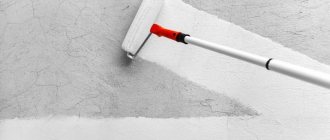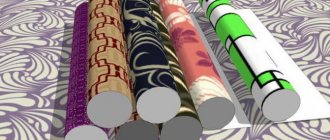8663 0 0
Savig June 14, 2017Specialization: master of interior finishing works. I am well versed in power tools for repair and construction. Formerly a teacher at a radio engineering college.
Before installing the tiles, plasterboard sheets must be carefully prepared
Don't know how to prepare drywall for tiling? The experience I have accumulated allows me to say that any home craftsman can cope with this task. Detailed instructions containing relevant photo illustrations will help me prove this.
Gypsum and tiles are a good combination
Tile requires perfectly smooth walls. However, in many homes this is very difficult to achieve. Many defects in the form of unevenness, as well as the general curvature of the walls, become a big problem when we need to glue tiles on them.
Drywall is one of the fastest ways to level walls. We can mount products made from this material on a frame or directly on the walls in the shortest possible time and without the need to have high knowledge of finishing. At the same time, using a double layer of gypsum plasterboard in combination with moisture-resistant options, it is possible to create a durable base that can withstand the weight of the tiles, will not collapse under severe external influences, and can even be used in rooms with high humidity levels, such as a bathroom.
Important! All of the above is possible if the tiles are laid well. And the primer plays a critical role in this matter.
How to treat drywall before laying tiles?
A quick and clean dry way to level walls with any differences is gypsum board sheathing. After this, you should decide how to putty the drywall, and whether it should be done. Practice shows that plasterboard sheets must be processed over the entire surface. The filling method depends on the final finish.
How to lay tiles on drywall: professionals advise
The widespread use of plasterboard is justified by its ease of use and the variety of subsequent finishing. The material can serve as a basis for installing partitions, slopes, and is also used to level the treated area. The question often arises about the use of such sheets when finishing with tiles.
With the advent of modern materials that are moisture resistant, this has become possible, because tiles are usually used to create the interior of a bathroom, toilet, kitchen, where humidity levels are high. Using drywall, you can perfectly prepare the surface for finishing.
Subsequent laying of tiles on drywall does not require any complex operations.
Features of using gypsum plasterboard together with tiles
Tiled elements are placed only on a flat area to ensure structural strength and give the finish a beautiful appearance. Several years ago, before laying the tiles, a gypsum compound or cement-sand plaster was applied. However, this method of rough finishing combined high costs in the case of an uneven wall and a long processing time. Later, many craftsmen began to use plasterboard under tiles instead of gypsum finishing composition.
When ceramic tiles are laid on drywall, there is no dirt or dust. There is also no need to wait for the solution to dry, which speeds up the finishing process. However, before answering the question of how to lay tiles on drywall, you need to choose the appropriate type of material.
Types of drywall
How to choose the right source material for finishing? The following types of plasterboard material are known:
- GKL - standard sheets that do not have distinctive characteristics. They are used in arranging partitions and leveling walls in rooms. They are characterized by a white or gray color.
- GVL is a moisture-resistant sheet, which allows it to be used in humid conditions when humidity parameters do not change.
- GVLV - the material is supplemented with hydrophobic impregnation, which affects the material’s resistance to high humidity. However, humidity levels may be unstable. The sheets are used in the renovation of showers, bathrooms, kitchens, and terraces. The outer cardboard is made in green color.
- GKLO is a material with fire resistance characteristics. It is used when arranging saunas, in bathhouses where there is a high level of fire hazard. The leaves are pink in color.
Tiles on drywall in a bathroom or other room where high humidity is possible are mounted on moisture-resistant sheets.
Advantages and disadvantages of technology
Tiling plasterboard is a method that is often used in practice. This is due to the many advantages of drywall:
- A universal material used for various types of finishing;
- The material is easy to process;
- You can lay the entire sheet on the wall or cut it into sections of the required size;
- You can do the cladding yourself;
- The material does not contain harmful chemical compounds.
By choosing the technology of laying tiles on drywall, you reduce repair time and reduce the labor intensity of the finishing process.
Source: https://stroi-store.ru/chem-obrabotat-gipsokarton-pered-ukladkoy-plitki/
Is it necessary to putty drywall under tiles?
The question of whether it is necessary to plaster the gypsum board before gluing the tiles is asked by many, and the answer to it is obvious - no. After all, the main task of putty is to level the surface, whereas in the case of drywall everything is already as level as possible. All that needs to be done is to prepare the plasterboard surface for better adhesion with tile adhesive, for which a primer is used.
Tips for laying tiles on plasterboard walls
Leveling gypsum plasterboard walls has long been a favorite for everyone who makes repairs on their own. It is used in almost all rooms and always gives good results. Only sometimes people have doubts: is it possible to lay tiles on drywall? And if so, how is this done? In order not to get lost in doubt, let us take a closer look at this issue.
So: do they lay tiles on gypsum boards? Builders assure that your favorite ceramic coating will adhere perfectly to this material if you do not violate certain technologies and understand some of the nuances of performing the work.
What do they want to achieve by using drywall primer for tiles?
- Ensuring better adhesion of the tiles to the surface of the drywall;
- The glue is distributed more evenly over the primed surface;
- When dismantling the tiles, the process will not occur together with fragments of plasterboard sheets;
- The primer helps prevent the appearance of mold and mildew on the walls;
- The soil also has water-repellent properties, which prevents gypsum board from swelling even when used in places with high humidity.
How to prime drywall - process technology
Do I need to prime drywall? This question was often asked quite recently. Many ordinary people could not understand why this material was needed, because the surface of drywall is smooth and even, and putty solutions adhere perfectly to it. It's all about the quality of the work performed.
Judge for yourself. The primer is intended to strengthen the surface and create a layer that will have a high rate of adhesion (bonding). This means that the materials applied to the primed surface will hold strong and for a long time, which is what the craftsmen strive for in the process of carrying out repair work.
Plasterboard wall being primed
Attention! The consumption of finishing materials on a primed surface is reduced several times. And this is the economic side of the issue.
Here are all the advantages of using a primer. It seems not as much as we would like, but taking into account all of the above, we can note quality, durability, and efficiency. What else do you need?
Choosing a primer for the job
Ideal options for priming drywall are latex or acrylic based compositions. These types of primers have all the necessary properties and also dry quite quickly. Already four hours after application, you can begin directly gluing the tiles. However, the ideal time to start further work, be it putty or gluing porcelain tiles, is better to start after a day. It is important to remember that when applied to a plasterboard sheet, the primer should not contain a solvent.
In this case, it is necessary to choose the type of product that corresponds to the further finishing. For example, if it is acrylic paint, then it is better to choose an acrylic primer. But in general, all types of soil for such materials are divided into penetrating and strengthening. The first differs in that it has a finer filler. This composition allows it to penetrate to a significant depth - up to 10 millimeters. If you have to prime a surface that has already been finished in some way, then the second option is chosen. By the way, penetrating compounds are also more expensive.
In general, you need to look at the following parameters:
- In the penetrating primer, the solids content does not exceed 12 percent, which ensures its deeper penetration into the body of the gypsum board;
- It is easy to distinguish the compositions by appearance. In the strengthening primer, due to the higher content of solid components, the color is almost milky. At the same time, in most cases, the penetrating version of the liquid appears translucent and cloudy;
- If gypsum plasterboard is applied to the surface, the penetrating composition will be absorbed very quickly, while the strengthening composition will leave a clearly visible glossy mark on the surface.
Wet and damp areas in the bathroom
Materials used to insulate wet areas must be waterproof and resistant to biological corrosion, that is, to the action of mold and mildew. At the same time, they must be elastic in order to withstand tensile deformation during operation.
Roofing felt. Typically, waterproofing in wet rooms is made of two or three layers of roofing felt. For this purpose, roofing material based on fiberglass or polyester is used. To ensure that the insulation forms a continuous layer, sheets of roofing felt are laid overlapping and then fused by heating the edges with a burner, or glued together with bitumen mastic.
Film. There are special films designed for wet areas.
Most often they are made of high-density polyethylene or polyvinyl chloride. The film may have additional layers (for example, heat-reflecting); This film is used for heated floors. A tight seam can be obtained by heating the edges of the film or gluing them with adhesive tape.
Liquid bitumen mastic.
An easy-to-use material is liquid bitumen-latex mastic. After applying mastic twice to the surface of the floor and walls, a continuous, homogeneous insulating film is formed. The corners of the walls and the joints of the walls and floor are further strengthened by embedding a special tape into the insulating layer.
Cement-polymer mass. Another waterproofing material is waterproof masses based on cement and polymer components.
They are applied with a roller or spatula. The corners are sealed with special tape, and special insulating elements are applied to the drain holes and pipes. After hardening, such masses form a rough surface on which tiles can be laid.
Moisture-resistant plasterboards. A relatively new material on the construction market. These slabs do not have waterproofing properties, but are only characterized by increased resistance to moisture, so they should not be exposed to it for a long time, and in places of contact with water they must be additionally primed.
The plasterboard boards on which the tiles will be laid must have increased strength and rigidity, so it is better to use thick boards or install them in two layers.
Repair work in the kitchen or bathrooms requires special attention in the selection of finishing materials used in the interior.
High humidity and changing temperature conditions in these rooms create an aggressive environment that negatively affects materials. Drywall is widely used for finishing work. This material allows you to significantly reduce the time required for repair work and fulfill any design idea. In damp and damp rooms, special moisture-resistant plasterboard is used for finishing.
The procedure for priming plasterboard sheets under tiles
- Only a clean surface needs to be primed. Therefore, we thoroughly clean the outer layer of the gypsum board from dust and dirt;
- Having prepared the solution and poured it into a container for ease of work, we begin to apply the composition to the surface of the plasterboard using a roller with fine pile or a fairly wide brush. In this case, corners and other fragments that require a more subtle approach can be treated with a narrow brush;
- Do not forget to do vertical shading in order to cover the entire surface of the sheet with an even layer without smudges or missing spots;
- After the first layer of primer has set, it is highly advisable to repeat the procedure.
Ways to protect drywall from moisture in the bathroom ↑
It is necessary to indicate that only moisture-resistant sheets marked GKLV are used in the bathroom. The protective cardboard layer of this material is green or blue. Impregnation with an antiseptic hydrophobic composition helps it resist high humidity. Additional protective measures are carried out as follows.
Bitumen mastic is applied to the rough side
- Before installation, the back surface of the gypsum board is treated with waterproofing mastic from Knauf or Flachendicht. It does not contain organic solvents; after application and complete drying, a hydro-vapor barrier film with a high degree of adhesion is formed on the surface.
- After installation, treat the ends with exposed gypsum fiber with silicone sealant or Dolphin water-repellent.
- A good result is obtained by treating the sheets with PVA glue after applying a deep penetration primer.
- Treatment with “Hydrostop” produced by Knauf or rubber waterproofing.
- The internal corners formed by the joints of the sheets are treated with primer, after which a waterproofing tape 200 mm wide is glued. The waterproofing agent is reapplied on top so that the tape is completely covered. It is necessary to apply the product evenly so that there are no problems when laying the tiles. External corners are also protected in the same way.
- Pay special attention to the lower part of the walls, near the floor. The appearance of moisture in this area is most likely. For processing, pasting or coating materials based on bitumen are used. They begin to spread the mastic on the floor, then on the wall so that it extends onto the walls (to a height of about 200 mm). The walls near the shower cabin and bathtub are completely processed. For better protection, the mastic is applied in several layers.
Treating the bottom of the walls with mastic.
- Adhesive waterproofing is used: glassine, roofing felt or roofing felt is glued onto the back side of the drywall, after treating it with a bitumen or polymer composition. Bitumen-polymer membranes are also effective.
- Waterproofing penetrating materials consisting of cement, crushed sand, and chemically active substances are applied to gypsum board sheets in a layer of 1–3 mm. Crystals of the substance, penetrating into pores and cracks, seal them. In this case, the base should also be treated (so that it does not absorb condensation). Products such as “Silar”, “Dolphin”, “Hydrozit” and others are used.
Waterproofing mixture.
- Protecting gypsum fiber boards with ordinary oil paint is effective. It should be applied to the back side of the material with a brush in two or three layers. The front side is not processed in this way: this will make it impossible to cover the walls with ceramic tiles.
- Walls can be decorated with paint. For application to gypsum boards, select a waterproof paint, which is applied after treating the base with a primer.
the perimeter is covered with waterproofing
All these methods will be effective only if there is good forced ventilation in the room. If this is not possible, the use of drywall should be abandoned.
Do I need to prime drywall before plastering it?
Tile is not laid on a gypsum board base as often as plastering is done. This method is the most popular in matters of further finishing of drywall. But is it necessary to treat this material with a primer before plastering? In general, yes, since the main task of this method, which is to increase adhesion, is also relevant here.
Since putty, unlike tile itself, cannot provide a smooth surface simply by the mere fact of its presence, it is necessary to prepare this very surface for it. And the main thing here is to process the seams and the locations of the screws. The process looks like this:
- After installing the gypsum board sheets, we apply a primer to the seams and the locations of the screws, after which we treat them with plaster;
- As soon as the putty has dried, we again treat the gypsum board with a primer, but this time the entire surface. As soon as it dries, apply a leveling layer of putty of small thickness. If necessary, a reinforcing mesh is installed;
- After this, we coat the already applied putty with a primer. And then all that remains is to apply the finishing layer.
Thus, using soil and, possibly, a reinforcing mesh, we have created a layer of plaster that will last as long as possible and withstand the most severe external influences.
Materials and tools
How to prepare drywall for tiles will be described further, but before that you should collect a set of necessary tools and materials. For puttying and priming you will need:
- spatulas, narrow and wide
- notched trowel for tiles
- building level
- tile cutter
- rubber hammer
- spacer plastic crosses, corners
- roller or brush to apply primer to drywall under tiles
- reinforced tape
- sandpaper
- container for primer, putty
One of the frequently asked questions to professionals is “What is the thickness of drywall for walls under tiles?” The most optimal sheet thickness is 12.5 mm.
Plasterboard tiling ↑
The problem of waterproofing must be solved as a whole, so do not forget about treating with a primer before tiling with ceramic tiles. You can also use waterproofing mastics.
The tiles are fixed with waterproof glue. It is applied to the entire surface and spread with a notched spatula. Particular attention must be paid to the grout: it must be hydrophobic. It is pressed tightly into the seams to prevent moisture from penetrating between the tiles. For additional protection, use a special varnish that is applied over the grout.
The seams between the tiles are sealed with moisture-resistant grout
For effective moisture-proof treatment of gypsum fiber boards, it is recommended to invite specialists. This will help avoid damage to materials, which means the bathroom will retain its attractive appearance for many years.
